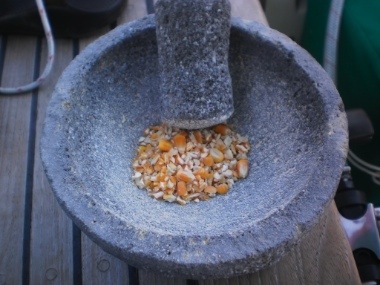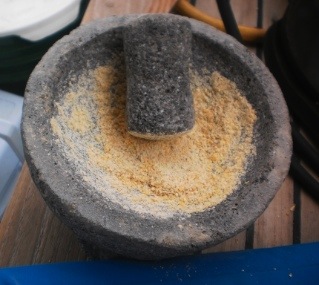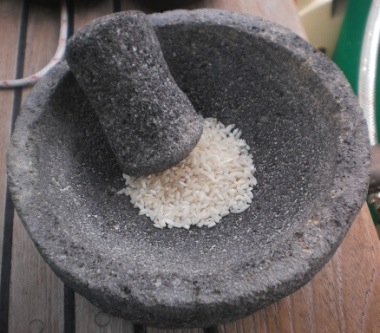Tuesday, March 6, 2012
3/6/2012 - Last post on Blogspot
3/6/2012 - Bread and a rug
Out in front of the Telcel (phone company) office, there is usually a tiny little old lady stationed right by the front door selling something. I had to go to the office to renew my banda ancha card and, on the way out I decided to stop and find out what she was selling. She told me what it was but I hadn't a clue what she said. I told her I didn't know what she meant, so she opened up the basket and inside were these little golden loaves. She told me again what they were but all I got was that they were made of corn and she made them. I was feeling pretty flush since we had just left the fruteria where we bought a large cucumber, a yellow and a red bell pepper, eight good-size shallots, and about a dozen limons for 20 pesos (about $1.65) so I decided to splurge and spend the 30 pesos on one of her loaves. Got it back to the boat and cut into it.

Lulu and I each tried a piece. It was so good. It's a very moist, sweet corn bread of sorts. Didn't need any butter or anything on it and it was so moist that it was easy to eat even with nothing to drink alongside. We ended up eating the whole thing. Decided I need to go back and get another one, maybe tomorrow, and try harder to find out what it's called. This stuff would go great with coffee in the morning or even for dessert. If I can find out the name, we can probably find a recipe somewhere. Not that we begrudge the little old lady her money, but she won't always be available.
Lulu went to the dentist to get a tooth looked at. She felt like she'd chipped it and was worried that it might be a good spot for a cavity to get started. The dentist checked it out, smoothed the rough edge down a bit and told her that, if she was pretty sure she could keep it clean, it shouldn't cause any problems at all. Cost for this service? $0.00 pesos or about $0.00 US. That's right. She wouldn't take any money.
After we took our groceries back to the boat, we headed back downtown to see the big cultural sale and craft show. It's a yearly event. Artisans from all over Mexico gather under tents and sell their wares for about a week. We looked at a lot of handicrafts. We also sampled about 6 different kinds of mole, the uniquely Mexican sauce made primarily of chocolate and chiles. There were about 6 booths selling mole base in either solid or powdered form as well as other spices.

We also found something we've been looking for for awhile. We wanted a rug to cover what little bit of floor we have. We'd seen boats with Oriental rugs that looked really cool. But we needed what essentially amounts to a short hall runner. We thought it'd be kind of cool to have a Mexican rug rather than Asian and today we found it.

It's wool and the colors are all vegetable dyes. And it goes really well with our woodwork and, at about $50.00 (US), it wasn't too bad of a deal either.
On another tack entirely, I have to tell you about the tequila we bought last week. We had gone to the beach on the north end of town (Cerritos) for a late lunch at The Last Drop. I had heard that they make their own tequila so I figured we needed to give it a try. We each ordered a shot. It was amazing! It was a smooth as a timeshare salesman's line and as sweet as the deal he's offering. Absolutely no bite at all (unlike the timeshare guy's deal). Tasted like no other tequila we've ever had. It was so good that we bought a liter to go. The waiter just held a water bottle under the spigot on the barrel and filled it up. Here are the three amigos:

Mayorazgo, on the left, is the main tequila we've bought since we've been down here. Under 100 pesos and tastes as smooth as tequilas costing twice as much. Next is Los Osuna which you may remember from the blog about the tour of the Los Osuna agave farm and distillery. On the right is the water bottle filled with The Last Drop's house special tequila. This one is the best of the three as far as I'm concerned.
I cooked up some Creamy Chicken and Greens with Roasted Poblano and Caramelized Onion a couple nights ago and we had enough for two dinners. It's a really good recipe. You ought to try it at home. Tonight Lulu's making a vegan dish: Spicy Peanut Noodle Salad with Cucumbers, Red Peppers, and Basil. We're loving the recipes we've been using from Serious Eats and The Homesick Texan.
Monday, March 5, 2012
3/5/2012 - Molcajete
Okay, let me just start by saying that, at the moment, I'm less than impressed with molcajetes. This may, and probably will change as I gain experience but right now....
But first, let's start with the seasoning process. As I said before, molcajetes are made from volcanic basalt. Beware of the cheap-o imitations made in whole or in part from concrete. These will never get properly seasoned. Seasoning basically consists of getting rid of all the grit that's going to slough off when you start grinding two volcanic rocks (the molcajete and the tejolote) together.
I checked Google to find out what the seasoning procedure was. I found a couple of youtube videos showing how to do it. Some folks opted for the industrialized easy way out and attacked the bowl with a very stiff wire brush on an electric grinder followed by a rinse with a high pressure washer. This would probably do the trick in a relatively short time. But these kitchen tools have been around for hundreds, maybe thousands of years and this approach just seems kind of, well, disrespectful. Other, more traditional methods were primarily geared around grinding uncooked rice to a fine powder as many times at it takes to have the rice powder not come out gray looking from the pumice dust. This could be just a couple times or as many as eight times, maybe more. After the dry rice procedure, rice mixed with a little water is ground up, forming a paste. When the paste stays white, you're ready to go.
I was just about to break out the rice when I found an even more traditional method. Lesley on The Mija Chronicles explains the right way to season a molcajete as well as the way she did it (aka: the wrong way). In this method, you start by grinding cracked corn to dust (4 times), then dried beans (4 times), then dry rice (4 times), and finally rice and a bit of water (3 times). This made sense to me . It's sort of like starting with 60 grit sandpaper and working your way down to 220 grit.
So, armed with my grains, my brush and my stone-age tools, I got to work.
First the corn:

After about 20 minutes I had a couple tablespoons of fine cornmeal.

Repeated this 3 more times and then, the beans:

The beans were harder. Probably because their round smooth shape made grinding them difficult. Once they broke open they were somewhat easier.

Again, I repeated this procedure 3 more times. Each time took about 20 minutes. Finally it was time for the grain that most instructions started with, the rice:

Repeated this 3 more times and then it was finally time for the rice/water slurry. For some reason, I didn't take pictures of this step but I'm sure by now you can imagine what it looked like. The final step in seasoning a molcajete is actually seasoning it. Everyone agrees that you grind up garlic and salt. After that, some recommend coriander, some oregano, some other stuff. I used what was on hand: garlic, salt and oregano. And, as long as I was grinding up the stuff anyway, might as well make some salsa, right?
I wasn't following any actual instructions for this. I just sort of had a vague idea that you put the vegetables in the molcajete and ground them all up together. So, I coarsely chunked up a couple of jalapeños, three tomatoes, an onion, and a handful of cilantro. To this I added some salt and started grinding.
Well, it didn't go quite as I hoped. Whenever we're in a restaurant down here (I almost said a Mexican restaurant), the salsa Mexicana that is served is obviously just cut up with a knife. Salsa Mexicana is what we commonly refer to in the US as Pico de Gallo. It's simply raw tomatoes, chiles, onions, garlic, and cilantro chopped up and mixed together. And it's chopped up with a knife, not a molcajete. I'm pretty sure I now know the reason for this. It's all about the skin.
In the few salsa-in-a-molcajete procedures I saw on youtube, they started with roasted vegetables. This is only partly to impart a char flavor. The bigger reason is that roasting the tomatoes and peppers under the broiler until they're blackened, and then letting them steam inside a bag for a few minutes, makes it really easy to peel the skins off. Why do we want the skins off? Because they're freakin' tough, that's why. I ground and I ground my raw vegetables in that molcajete and still the skins held together. Finally, on Lulu's suggestion, I dumped the whole mess in the string-pull food processor and chopped it up properly. But, hell, if I was going to use the food processor, why bother with the molcajete at all. No good reason, that's why.
So, my first molcajete experiment was a bust. Next time I'll roast and skin the vegetables like I'm supposed to. And maybe up the tomato to jalapeño ratio too. Either that or just make some quacamole. That shouldn't be too tough to grind up. I am happy to say that I haven't found any grit in the salsa yet.
Saturday, March 3, 2012
3/3/2012 - Let's get caught up




